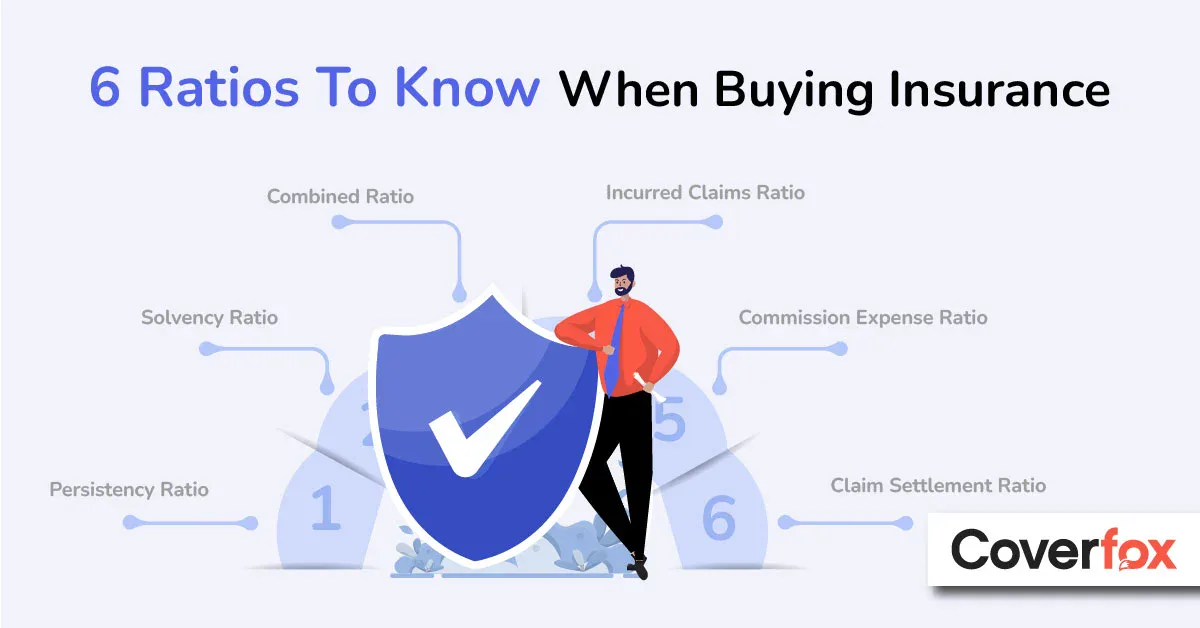Term Insurance ratios serve as a compass in this journey. They provide insights into an insurer's financial stability and operational efficiency. In this article, we will delve into six key insurance ratios. These include the Commission Expense Ratio, Combined Ratio, Persistency Ratio, Claim Settlement Ratio, Solvency Ratio, and Incurred Claims Ratio.

Introduction to Insurance Ratios
Insurance ratios are financial metrics used to assess an insurance company's performance. They are derived from the company's financial statements.
These ratios provide a snapshot of the insurer's financial health. They indicate the company's profitability, solvency, and efficiency in managing claims and expenses.
Why Insurance Ratios Matter
Insurance ratios matter because they help you gauge the reliability of an insurance company. A financially stable insurer is more likely to honor its commitments to policyholders.
Moreover, understanding these ratios can guide you in choosing the right insurer. It empowers you to make informed decisions and get the best value for your money.
1. Commission Expense Ratio
The Commission Expense Ratio is a key metric in the insurance industry. It measures the proportion of premium income that an insurer spends on commissions and related expenses.
This ratio is calculated by dividing the total commission and acquisition costs by the total premium income. The result is expressed as a percentage.
Understanding Commission Expense Ratio
A lower Commission Expense Ratio indicates a more cost-efficient operation. It means the insurer is spending less on acquiring and retaining customers.
On the other hand, a higher ratio may suggest that the insurer is investing heavily in its sales force. It could also mean that the insurer is relying more on brokers and agents to sell its policies.
The Impact on Your Insurance
The Commission Expense Ratio can impact your insurance premiums. Insurers with higher ratios may pass on the cost to policyholders through higher premiums. Therefore, it's wise to consider this ratio when comparing insurance providers.
2. Combined Ratio
The Combined Ratio is another crucial metric in the insurance industry. It measures an insurance company's profitability from its underwriting activities.
This ratio is calculated by adding the loss ratio and the expense ratio. The result is expressed as a percentage.
Breaking Down the Combined Ratio
A Combined Ratio below 100% indicates an underwriting profit. It means the insurer is earning more in premiums than it is paying out in claims and expenses.
On the other hand, a Combined Ratio above 100% signals a loss. It suggests that the insurer's underwriting activities are not profitable and it is paying out more in claims and expenses than it is earning in premiums.
Significance for Policyholders
The Combined Ratio can give policyholders an idea of an insurer's financial health. A consistently high Combined Ratio may indicate a riskier insurer, which could potentially affect claim settlements.
3. Persistency Ratio
The Persistency Ratio is a key indicator of customer retention in the insurance sector. It reflects the percentage of policies renewed by customers over a specific period.
The number of policies renewed divided by the total number of policies in effect at the beginning of the term yields this ratio. After that, the result is multiplied by 100 to obtain the percentage.
The Meaning of Persistency Ratio
A high Persistency Ratio suggests that a large proportion of customers are renewing their policies. This can indicate customer satisfaction and financial stability of the insurer.
On the other hand, a low Persistency Ratio may signal customer dissatisfaction or competitive pressures. It could also suggest issues with the insurer's pricing or service quality.
Why It Matters for You
As a policyholder, the Persistency Ratio can provide insights into the insurer's customer service quality. A high ratio may suggest a higher likelihood of a smooth claims process and satisfactory customer service.
4. Claim Settlement Ratio
The Claim Settlement Ratio is another crucial metric in the insurance industry. It represents the percentage of insurance claims an insurer has paid out during a fiscal year.
To compute this ratio, divide the total number of claims that have been settled by the total number of claims that have been received. To obtain a percentage, the outcome is then multiplied by 100.
Exploring Claim Settlement Ratio
Higher Claim Settlement Ratios are frequently regarded as indicators of trustworthy insurers. It suggests that the insurer is more likely to honor its commitments and settle claims.
However, a lower ratio doesn't necessarily mean an insurer is unreliable. It could be due to stringent claim verification processes or a higher number of fraudulent claims.
How It Affects Insurance Buyers
For insurance buyers, the Claim Settlement Ratio can be a key factor in choosing an insurer. A high ratio may indicate a higher likelihood of your claim being settled. It's a good idea to compare this ratio among different insurers before making a decision.
5. Solvency Ratio
The Solvency Ratio is a key measure of an insurance company's financial health. It indicates an insurer's ability to meet its long-term debt obligations and other financial commitments.
This ratio is calculated by dividing the insurer's net after-tax income by its total debt obligations. After that, the result is multiplied by 100 to obtain the percentage.
Solvency Ratio and Its Importance
Regulators typically require a minimum Solvency Ratio to ensure the insurer can cover claims under adverse conditions. An insurer with a greater Solvency Ratio is thought to be more stable financially.
However, a very high Solvency Ratio may not always be beneficial. It could indicate that the insurer is not using its capital efficiently to generate profits.
What This Means for Consumers
For consumers, the Solvency Ratio can provide insight into an insurer's financial stability. A stable insurer is more likely to honor its commitments and settle claims. Therefore, it's wise to consider this ratio when choosing an insurer.
6. Incurred Claims Ratio
The Incurred Claims Ratio (ICR) is another crucial insurance ratio. It compares the total value of claims paid to the total premium received by the insurer.
The ICR is calculated by dividing the total claims paid by the total premiums collected. After that, the outcome is multiplied by 100 to get the percentage.
Incurred Claims Ratio Explained
An elevated ICR may suggest that the insurer is disbursing a substantial amount of its premiums towards claims. This could suggest a higher risk profile for the insurer's policyholders.
On the other hand, a very low ICR may indicate that the insurer is not paying out many claims. This could be due to stringent claim approval processes or a lower risk profile of policyholders.
The Relevance to Policyholders
For policyholders, the ICR can provide insights into the insurer's claim settlement practices. A balanced ICR is often seen as a positive sign. It suggests that the insurer is neither too risky nor too stringent in settling claims. Therefore, policyholders should consider this ratio when evaluating insurers.
Conclusion
Understanding and using insurance ratios can empower consumers to make informed decisions. These ratios provide valuable insights into an insurer's financial health, claim settlement practices, and customer retention rates.
Also Read: What Happens If The Nominee Dies In Case Of a Term Plan?
.jpg)

